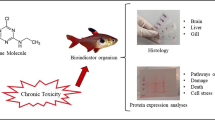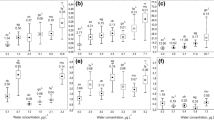Abstract
The morphological alterations of hepatocytes of female zebrafish,Brachydanio rerio, and fingerling rainbow trout,Salmo gairdneri, following prolonged exposure to 0.04, 0.2 and 1 mg/L of 4-chloroaniline were investigated by means of light and electron microscopy. Changes in peroxisomes were visualized by cytochemical demonstration of catalase activity after incubation in the alkaline diaminobenzidine medium. The amount of storage products was illustrated by the silver impregnation technique.
In a dose-dependent manner, the reaction of female zebrafish liver is characterized by a disturbance of hepatocytic compartmentation, progressive fenestration and fractionation of the rough endoplasmic reticulum (RER), a decrease in the number of peroxisomes and catalase activity, stratified inclusions in mitochondria, and an augmentation of lysosomes and myelinated bodies. Trout hepatocytes display nuclear inclusions, fractionation and vesiculation of the RER, and an increase in mitochondria, but a decrease of peroxisomes and catalase activity. Whereas glycogen stores are exhausted at 1 mg/L 4-chloroaniline, lipid deposits are amplified. An elevated rate of hepatocytic mitosis as well as the occurrence of glycogen-condensing cells probably derived from hepatocytes indicate the induction of proliferative processes in trout liver.
Evaluation and comparison of results with earlier reports suggest that despite the unspecificity of some alterations the combination of pathological symptoms yields a syndrome specific of the species and the substance studied. As a consequence, histological and cytological investigations are recommended as a routine supplement in an integrated test schedule for the assessment of sublethal effects of pollutants in the aquatic environment.
Similar content being viewed by others
References
Allen FJ, Carstens LA, Norback DH, Loh PM (1970) Ultrastructural and biochemical changes associated with pyrrolizidine-induced hepatic megalocytosis. Cancer Res 30:1857–1866
Atri FR (1986) Chlorierte Kohlenwasserstoffe in der Umwelt. IV. Chlorbenzol, 1,2,4-Trichlorbenzol, Chlornitrobenzole, Chloraniline, 2-Chlorethanol, 1,3-Dichlorpropanol(2), Epichlorhydrin. Schriftenr Ver Wasser Boden Lufthyg 70:607
Bailey GS, Hendricks JD, Nixon DE, Pawlowski NE (1984) The sensitivity of rainbow trout and other fish to carcinogens. Drug Metab Rev 15:725–750
Benedeczky I, Biro P, Schaff ZS (1984) The effect of 2,4-D-containing herbicide (Dikonirt®) on the ultrastructure of carp (Cyprinus carpio) liver cells. Acta Biol Szeged 30:107–125
Benedeczky I, Nemcsok J, Halasy K (1986) Electron microscopic analysis of the cytopathological effect of pesticides in the liver, kidney and gill tissues of carp. Acta Biol Szeged 32:69–91
Berlin JD, Dean JM (1967) Temperature-induced alterations in hepatocyte structure of rainbow trout. J Exp Zool 164:117–132
Braunbeck T, Storch V, Nagel R (1989a) Sex-specific reaction of liver ultrastructure in zebrafish (Brachydanio rerio) after prolonged sublethal exposure to 4-nitrophenol. Aquatic Toxicol (in press)
Braunbeck T, Burkhardt-Holm P, Storch V (1989b) Liver pathology in eels (Anguilla anguilla L.) from the Rhine river exposed to the chemical spill at Basle in November 1986. Arch Hydrobiol (in press)
Bresch H (1982) Investigation of the long-term action of xenobiotics on fish with special regard to reproduction. Ecotoxicol Environ Safety 6:102–112
Bresch H, Beck H, Ehlermann D, Schlaszus H, Urbanek M (1990) A Long-Term Toxicity Test Comprising Reproduction and Growth of Zebrafish with 4-Chloroaniline. Arch Environ Contam Toxicol, 19:419–427
Chapman GB (1981) Ultrastructure of the liver of the rainbow trout (Salmo gairdneri). J Fish Biol 18:553–567
Corke CT, Bunce NJ, Beaumont AL, Merrick RL (1979) Diazonium cations as intermediates in the microbial transformation of chloroanilines to chlorinated biphenyls, azo compounds, and triazines. J Agric Food Chem 27:644–646
Cost AJ (1984) Analysis of organic micropollutants in water. Commission of the European Communities, Brussels. 4th ed
Couch JA (1975) Histopathological effects of pesticides and related chemicals on the liver of fishes. In: Ribelin WE, Magaki G (eds) The pathology of fishes. University of Wisconsin Press, Madison, pp 559–584
De la Iglesia F, Sturgess JM, Feuer G (1982) New approaches for the assessment of hepatotoxicity by means of quantitative functional-morphological relationships. In: Plaa G, Hewitt WR (eds) Toxicology of the liver. Raven Press, New York, pp 47–102
Dumpert K (1987) Embryotoxic effects of environmental chemicals: Tests with the South African clawed toad (Xenopus laevis). Ecotoxicol Environ Safety 13:324–338
Dunkel VC, Simmon VF (1980) Mutagenic activity of chemicals previously tested for carcinogenicity in the National Cancer Institute Bioassay Program. In: Montesano R, Bartsch H, Tomatis L (eds) Molecular and cellular aspects of carcinogen screening tests. IARC Sci Publ 27:283–302
Freitag D, Scheunert I, Klein W, Körte F (1984) Long-term effect of 4-chloroaniline-14C in soil and plants under outdoor conditions. A contribution to terrestrial ecotoxicology of chemicals. J Agric Food Chem 32:203–207
Golly I, Hlavica. P (1985)N-oxidation of 4-chloroaniline by prostaglandin synthase. Redox cycling of intermediates. Biochem J 260:803–809
Golly I, Hlavica P, Wolf J (1984) The role of lipid peroxidation in theN-oxidation of 4-chloroaniline. Biochem J 224:415–421
Goodman DG, Ward JM, Reichardt WD (1984) Splenic fibrosis and sarcoma in F-344 rats fed diets containing aniline hydrochloride,p-chloroaniline, azobenzene,o-toluidine hydrochloride, 4,4′-sulfonyldianiline, or D & C red No. 9. J Natl Cancer Inst 73:265–273
Hacking MA, Budd J, Hodson K (1978) The ultrastructure of the liver of the rainbow trout: Normal structure and modifications after chronic administration of a polychlorinated biphenyl Aroclor 1254. Can J Zool 56:477–491
Hawkes JW (1980) The effect of xenobiotics on fish tissues: Morphological studies. Fed Proc 39:3230–3236
Hendricks JD, Meyers TR, Casteel JL, Nixon JE, Loveland PM, Bailey GS (1984) Rainbow trout embryos: Advantages and limitations for carcinogenesis research. Natl Cancer Inst Monogr (Bethesda) 65:129–137
Hendricks JD, Wales JH, Sinnhuber RO, Nixon JE, Loveland PM, Scanlan RA (1980) Rainbow trout (Salmo gairdneri) embryos: A sensitive model for experimental carcinogenesis. Fed Proc 39:3222–3229
Hinton DE, Kendall MW, Silver BB (1973) Use of histologic and histochemical assessments in the prognosis of the effects of aquatic pollutants. In: American Society for Testing and Materials, Philadelphia, Special Technical Publication 528:194–208
Hinton DE, Klaunig JE, Lipsky MM (1978) PCB-induced alterations in teleost liver: a model for environmental disease in fish. Mar Fish Rev 40:47–50
Hlavica P (1982) Biological oxidation of nitrogen in organic compounds and disposition ofN-oxidized products. CRC Crit Rev Biochem 12:39–101
Hwang HM, Hodson RE, Lee RF (1987) Degradation of aniline and chloroanilines by sunlight and microbes in estuarine waters. Water Res 21:309–316
Karnovsky MJ (1971) Use of ferrocyanide-reduced osmium tetroxide in electron microscopy. J Cell Biol 51: Abstr. 284
Klaunig JE, Lipsky MM, Trump BF, Hinton DE (1979) Biochemical and ultrastructural changes in teleost liver following subacute exposure to PCB. J Environ Pathol Toxicol 2:953–963
Korte F, Greim H (1981) Überprüfung der Durchführbarkeit von Prüfungsvorschriften und der Aussagekraft der Grundprüfung des E. Chem. G. Bericht der GSF München, Inst. f. Ökolog. Chemie und Inst. f. Biochemie u. Toxikol., Abt. Toxikol., an das Umweltbundesamt, Berlin. Forschungsbericht Nr. 107 04 006/1
Latorre J, Reineke W, Knackmuss HJ (1984) Microbial metabolism of chloroanilines: Enhanced evolution by natural genetic exchange. Arch Microbiol 140:159–165
LeHir M, Herzog V, Fahimi HD (1979) Cytochemical detection of catalase with 3,3′-diaminobenzidine. A quantitative reinvestigation of the optimal conditions. Histochem 64:51–66
Lenk W, Sterzl H (1982) Differences in the ferrihemoglobin-forming capabilities and carcinogenicities between monocyclic and polycyclicN-acrylamines and their derivatives. Rev Drug Metab Drug Interact 4:171–236
Lipsky MM, Klaunig JE, Hinton DE (1978) Comparison of acute response to polychlorinated biphenyl in liver of rat and channel catfish: A biochemical and morphological study. J Toxicol Environ Health 4:107–121
Lyons CD, Katz S, Bartha R (1983) Mechanisms and pathways of aniline elimination from aquatic environments. Appl Environ Microbiol 48:491–496
Malle KG (1984) Die Bedeutung der 129 Stoffe der EG-Liste für den Gewässerschutz. Z Was Abwas Forsch 17:75–81
McCain BB, Hodgins HO, Gronlund WD, Hawkes JW, Brown DW, Myers MS, Vandermeulen JH (1978) Bioavailability of crude oil from experimentally oiled sediments to English sole (Parophrys vetulus), and pathological consequences. J Fish Res Board Can 35:657–664
Messner B, Berndt J, Baum I (1979) Changes in fatty acid and cholesterol synthesis in rat liver slices due to aromatic amines formed during the degradation of some herbicides. Bull Environ Contam Toxicol 21:831–836
Metcalf RL, Li PY, Bowlus S (1975) Degradation and environmental fate of 1-(2,6-difluorobenzoyl)-3-(4-chlorophenyl)urea. J Agric Food Chem 23:359–364
Meyers TR, Hendricks JD (1984) Histopathology. In: Rand GM, Petrocelli SR (eds) Fundamentals of aquatic toxicology. Hemisphere, Washington DC. pp 283–331
Munk R (1984) Subletale toxische Wirkungen beim ZebrabärblingBrachydanio rerio. Prüfsubstanz: 4-Chloranilin. Environmental Protection Agency of the FRG, Berlin. Project No. 40F0265/83
Nagel R (1989) Long-term effects of 4-nitrophenol on reproduction and survival in zebrafish. Aquat Toxicol (in press)
Parris GE (1980) Environmental and metabolic transformations of primary aromatic amines and related compounds. Residue Reviews 76:1–30
Peute J, Van der Gaag MA, Lambert JGD (1978) Ultrastructure and lipid content of the liver of the zebrafish,Brachydanio rerio, related to vitellogenin synthesis. Cell Tissue Res 186:297–308
Peute J, Huiskamp R, Van Oordt PGWJ (1985) Quantitative analysis of estradiol-17β-induced changes in the ultrastructure of the liver of the male zebrafish,Brachydanio rerio. Cell Tissue Res 242:377–382
Poirier LA, Weisburger EK (1979) Selection of carcinogens and related compounds tested for mutagenic activity. J Natl Cancer Inst 62:833–840
Radomski JL (1979) The primary aromatic amines: Their biological properties and structure-activity relationships. Ann Rev Pharmacol Toxicol 19:129–157
Rankin GO, Yang DJ, Cressy-Veneziano K, Casto S, Wang RT, Brown PI (1986)In vivo andin vitro nephrotoxicity of aniline and its monochlorophenyl derivatives in the Fischer-344 rat. Toxicology 38:269–283
Reynolds ES (1963) The use of lead citrate at high pH as an electron-opaque stain in electron microscopy. J Cell Biol 17:208–212
Rez G (1986) Electron microscopic approaches to environmental toxicity. Acta Biol Hung 37:31–45
Richardson KC, Jarett L, Finke EH (1960) Embedding in epoxy resins for ultrathin sectioning in electron microscopy. Stain Technol 35:313–325
Rojik I, Nemcsok J, Boross L (1983) Morphological and biochemical studies on liver, kidney and gill of fishes affected by pesticides. Acta Biol Hung 34:81–92
Rudolph P, Boje R (1987) Ökotoxikologie. Ecomed, Landsberg, 160 PP
Salas M, Tuchweber B, Kourounakis P (1980) Liver ultrastructure during acute stress. Pathol Res Pract 167:217–233
Scarpelli DG, Greider MH, Frajola WJ (1963) Observations on hepatic cell hyperplasia, adenoma, and hepatoma of rainbow trout (Salmo gairdneri). Cancer Res 23:848–856
Scheele B (1980) Reference chemicals as aids in evaluating a research programme—selection aims and criteria. Chemosphere 9:293–309
Segner H, Juario JV (1986) Histological observations on the rearing of milkfish,Chanos chanos, fry using different diets. J Appl Ichthyol 2:162–173
Singh I (1964) A modification of the Masson-Hamperl method for staining of argentaffin cells. Anat Anz 115, 81–82
Sinnhuber RO, Hendricks DJ, Wales JH, Putnam GB (1977) Neoplasms in rainbow trout, a sensitive model for environmental carcinogenesis. Ann NY Acad Sci 298:389–408
Spurr AR (1969) A low viscosity embedding medium for electron microscopy. J Ultrastruct Res 26:31–43
Van der Bijl P, Gelderblom WCA, Thiel PG (1984) On the mutagenicity of parachloroaniline, a breakdown product of chlorohexidine. J Dental Assoc South Afr 39:535–537
Vassileva L, Kazakova M (1977) Parachloroaniline effect on human chromosomesin vitro. Med Biol Probl 5:243–247
Verschueren K (1983) Handbook of environmental data on organic chemicals. Van Nostrand Reinhold, NY, pp 356–357
Ward JM, Reznik G, Garner FM (1980) Proliferative lesions of the spleen in male F 344 rats fed diets containingp-chloroaniline. Vet Pathol 17:200–205
Wegmann RCC, De Korte GAL (1981) Aromatic amines in surface waters of the Netherlands. Water Res 15:391–394
Williams GM, Laspia MF, Dunkel VC (1982) Reliability of the hepatocyte primary culture/DNA repair test in testing of coded carcinogens and noncarcinogens. Mutat Res 97:359–370
Author information
Authors and Affiliations
Rights and permissions
About this article
Cite this article
Braunbeck, T., Storch, V. & Bresch, H. Species-specific reaction of liver ultrastructure in zebrafish (Brachydanio rerio) and trout (Salmo gairdneri) after prolonged exposure to 4-chloroaniline. Arch. Environ. Contam. Toxicol. 19, 405–418 (1990). https://doi.org/10.1007/BF01054986
Received:
Revised:
Issue Date:
DOI: https://doi.org/10.1007/BF01054986




